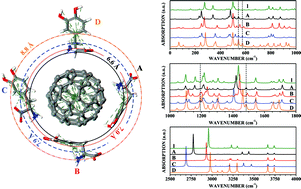Four-level levodopa adsorption on C60fullerene for transdermal and oral administration: a computational study†
Abstract
After more than fifty years, the administration of

Maintenance work is planned for Wednesday 1st May 2024 from 9:00am to 11:00am (BST).
During this time, the performance of our website may be affected - searches may run slowly and some pages may be temporarily unavailable. If this happens, please try refreshing your web browser or try waiting two to three minutes before trying again.
We apologise for any inconvenience this might cause and thank you for your patience.
* Corresponding authors
a Departamento de Física Teórica e Experimental, Universidade Federal do Rio Grande do Norte, 59072-970 Natal, Brazil
b Departamento de Biofísica e Farmacologia, Universidade Federal do Rio Grande do Norte, 59072-970 Natal, Brazil
c Departamento de Física, Centro de Ciências Exatas e Tecnologia, Universidade Federal do Maranhão, 65085-580 São Luís, Brazil
d Departamento de Química Analítica e Físico-Química, Universidade Federal do Ceará, Campus do Pici, 60455-900 Fortaleza, Brazil
e
Instituto Federal de Educação, Ciência e Tecnologia do Ceará, Fortaleza, Brazil
E-mail:
ewcaetano@gmail.com
Fax: +55-85-33073711
Tel: +55-85-33073666
f Departamento de Física Universidade Federal do Ceará Centro de Ciências, Caixa Postal 6030 Campus do Pici, 60455-760 Fortaleza, Brazil
After more than fifty years, the administration of

 Please wait while we load your content...
Something went wrong. Try again?
Please wait while we load your content...
Something went wrong. Try again?
N. F. Frazão, E. L. Albuquerque, U. L. Fulco, D. L. Azevedo, G. L. F. Mendonça, P. Lima-Neto, E. W. S. Caetano, J. V. Santana and V. N. Freire, RSC Adv., 2012, 2, 8306 DOI: 10.1039/C2RA20606D
To request permission to reproduce material from this article, please go to the Copyright Clearance Center request page.
If you are an author contributing to an RSC publication, you do not need to request permission provided correct acknowledgement is given.
If you are the author of this article, you do not need to request permission to reproduce figures and diagrams provided correct acknowledgement is given. If you want to reproduce the whole article in a third-party publication (excluding your thesis/dissertation for which permission is not required) please go to the Copyright Clearance Center request page.
Read more about how to correctly acknowledge RSC content.
 Fetching data from CrossRef.
Fetching data from CrossRef.
This may take some time to load.
Loading related content
